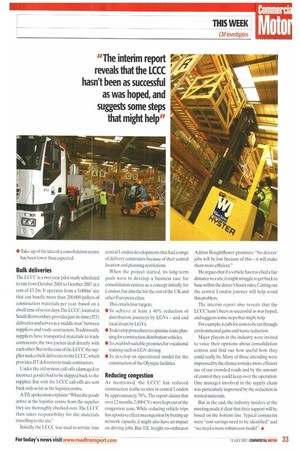London Construdion Consolidation Centre
Page 32

Page 33

If you've noticed an error in this article please click here to report it so we can fix it.
The London Construction Consolidation Centre has been operating for about 18 months — Dylan Gray finds out what it's all about and assesses its likely effect on operators working in the capital.
London's population is predicted to grow significantly over the next 20 years, boosting demand forjobs and homes.The construction industry will be kept busy meeting this demand.and while logistics has always been a vital part of the building trade, it has never been seen as a high priority —until recently.
In October 2005 Transport for London (TfL) teamed up with Wilson James, Stanhope, Constructing Excellence and Bovis Lend Lease toereate theLondonConstruction Consolidation Centre (LCCC). One and a half years on, the LCCC's first report has been published — and it includes some interesting statistics: • The number of construction vehicles entering the City of London and delivering to sites served by the LCCC has fallen by 68%.
• Going directly to the LCCC instead of into the City has cut journey times by an average of two hours.
• CO, emissions have been cut by approximately 75% (in comparison to what would have been produced by vehicles heading directly to building sites).
• Materials waste has been reduced by 15% through reduced damage and less shrinkage.
*The productivity of the labour force has risen by about 30 minutes per day (because the LCCC provides an instant supply of materials so labourers do not have to collect supplies). • Take-up of the idea of a consolidation centre has been lower than expected.
Bulk deliveries The LCCC is a two-year pilot study scheduled to run from October 2005 to October 2007 at a cost of £3.2m. It operates from a 5,000m2 site that can handle more than 200,000 pallets of construction materials per year, based on a dwell time of seven days. The LCCC, located in South Bermondsey.provides just-in-time (MT) deliveries and serves as a 'middle man' between suppliers and trade contractors. Traditionally suppliers have transported materials to trade contractors; the two parties deal directly with each other. But in the case of the LCCC the supplier makes bulk deliveries to the LCCC, which providesJIT deliveries to trade contractors.
Under the old system, call-offs (damaged or incorrect goods) had to be shipped back to the supplier. But with the LCCC call-offs are sent back only as far as the logistics centre.
ATfL spokesman explains:"When the goods arrive at the logistics centre from the supplier they are thoroughly checked over. The LCCC then takes responsibility for the materials travelling to the site."
Initially the LCCC was used to service four central London developments that had a range of delivery constraints because of their central location and planning restrictions.
When the project started, its long-term goals were to develop a business case for consolidation centres as a concept initially for London, but also the for the rest of the UK and other European cities.
This entails four targets: • To achieve at least a 40% reduction of distribution journeys by LGVs — and end local drops by LGVs.
• To develop procedures to optimise route plan ning for construction distribution vehicles. e'ro establish suitable premises for vocational training such as LGV driving.
• To develop an operational model for the construction of the Olympic facilities.
Reducing congestion As mentioned, the LCCC has reduced construction traffic to sites in central London by approximately 70%. The report claims that over 12 months,2,000CVs were kept out of the congestion zone. While reducing vehicle trips has a positive effect on congestion by freeing up network capacity, it might also have an impact on driving jobs. But TfL freight co-ordinator Adrian Boughtflower promises: "No drivers' jobs will be lost because of this — it will make them more efficient."
He argues that if a vehicle has travelled a fair distance to a site,it might struggle to get back to base within the driver's hours rules. Cutting out he central London journey will help avoid this problem.
The interim report also reveals that the LCCC hasn't been as successful as was hoped, and suggests some steps that might help.
For examplesit callsfor costs to be cut through environmental gains and waste reduction.
Major players in the industry were invited to voice their opinions about consolidation centres and find out how useful how they could really be. Many of those attending were impressed by the chance to make more efficient use of our crowded roads and by the amount of control they could keep over the operation. One manager involved in the supply chain was particularly impressed by the reduction in wasted materials.
But in the end, the industry insiders at the meeting made it clear that their support will be based on the bottom line. Typical comments were "cost savings need to be identified" and "we need a more robust cost model". •


























































































































































































